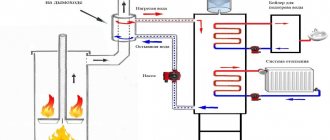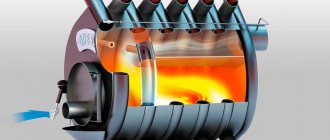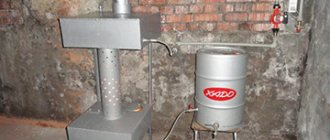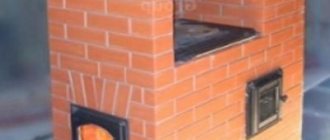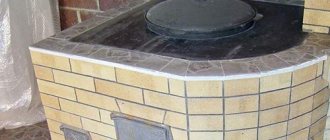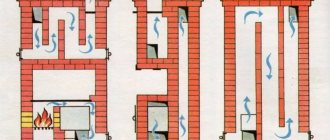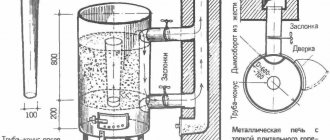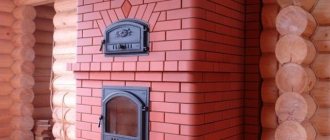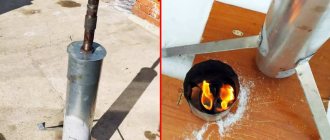Operating principle of a pyrolysis furnace
What is the operating principle of this stove? The processes occurring in it are unfamiliar to many, so it is necessary to study in more detail the principle of operation of a pyrolysis furnace.
A distinctive feature of a do-it-yourself pyrolysis furnace from a conventional one is that the fuel in it burns when there is a lack of oxygen. And this is surprising, because in conventional designs the fuel burns if there is a large amount of oxygen and this ensures the normal functioning of the entire heating system.
How does the pyrolysis process occur? When hydrocarbon fuels are burned, a process of oxidation and heat generation begins. Fuel under the influence of high temperature does not burn completely, releasing a large amount of various gases. The higher the temperature with a lack of oxygen, the more intense these gases begin to be released.
For example, if you burn wood fuel, gases such as acetic acid, acetone, and methyl alcohol will be released. Along with them, various resinous compounds and charcoal particles enter the chimney. These unburned residues can be re-burned because they are quite flammable. Gases that are not completely burned can be released when burning any fuel, such as natural organic matter or petroleum products. Different fuels have different combustion temperatures. Thus, petroleum products can burn at a temperature of 800-900 degrees, and firewood burns at 500 degrees.
Thus, the principle of operation of a do-it-yourself pyrolysis oven is to burn these gases. That is why such furnaces are also called gas generators. Pyrolysis is the process of decomposing fuel into its component parts when heated, followed by their combustion and release of heat.
Advantages and disadvantages of a pyrolysis furnace
This design has certain advantages over conventional ovens. These include:
- efficiency reaches 80%;
- fuel is consumed very economically;
- the ability to regulate the long-term combustion process;
- environmental friendliness. During operation, such a stove produces virtually no emissions of carcinogenic substances.
If a pyrolysis oven is made correctly, then its advantages are countless. For example, it has virtually no soot , which makes it easier to maintain cleanliness and spend a small amount of time cleaning the stove. And there are a lot of such small advantages.
However, the pyrolysis oven also has disadvantages:
- high price. It is more profitable to do it yourself;
- big sizes. If the room is not too large, it is better to use other heating structures;
- Such stoves are heated only with a certain type of fuel. Dry fuel (wood) is best suited because high humidity has a negative effect on the pyrolysis process;
- For its operation, a power supply is required, and a constant one at that. For best operation of the oven, it should be connected to an electrical network.
These are the main disadvantages of a pyrolysis oven. So you can safely operate such a stove if there is enough space for it, dry fuel is available and there is access to the electrical network.
Possible materials
For professional masons, brick : convenient, reliable and the Russian spirit is present.
The only trouble is that there are not enough such experts among ordinary citizens. The work of a master is not cheap, and there are a lot of unscrupulous people: either they slip in a low-quality project, or they make a poor solution. The result is that the oven does not heat well, smokes, or crumbles. An alternative option remains for ordinary people - a metal structure . Here are the options for solving the problem:
- buying a ready-made sample will cost more, but it will create less hassle;
- self-production (for amateur craftsmen).
Pyrolysis boiler manufacturing technology
To make a powerful boiler, you need to be able to handle an angle grinder and a welding machine, as well as understand the drawings. If you independently manufacture a boiler with a power above 25 kW, you must do everything according to the drawing , otherwise the boiler will not meet safety requirements.
The walls of the boiler should be made of heat-resistant steel, only this will guarantee that it will last for quite a long time. If such steel cannot be found, you can use ordinary steel, only in this case the internal chambers of the boiler are lined with fireclay bricks.
Boiler manufacturing stages.
- The boiler body is made of sheet steel. Using a grinder, boiler parts are cut out of a sheet of metal, holes are made in the walls for the ash pan door and loading door, as well as for pipes and a smoke exhauster. The most important thing is to adhere to the dimensions indicated in the drawing. Using a welding machine, the parts are connected, after which the seams are cleaned of scale and ground.
- Then the pipes are welded so that there are no gaps between the seams. A pipe of the required diameter is taken and a protective heat exchanger is installed on the rear wall of the boiler. After that, they check whether the heat exchanger is leaking due to increased pressure from the compressor, and only then install the rear wall of the chamber, made of heat-resistant steel.
- Then they begin to install a partition that separates the gasification and gas combustion chambers, installing a cast iron grate. An air duct with a damper is made at the top of the gasification chamber. An air duct is also made at the bottom of the chamber and at the same time the bottom and sides are lined with fireclay bricks.
- The boiler doors are made of heat-resistant steel, and for maximum tightness they are reinforced with metal corners.
- The boiler should be installed in a non-residential area, connecting the chimney. Then a water circuit is connected to it and a smoke pump is installed.
Manufacturing technology of a pyrolysis furnace
This boiler is very powerful and therefore suitable for a large house. To keep your garage or country house warm, you can build a pyrolysis oven with your own hands. It is also made from a sheet of metal, but its manufacturing technique is much simpler.
If the gas combustion chamber is located above the gasification chamber, creating natural draft, then there is no need to use a smoke exhauster.
The stove is not connected to the heating system.
Such a furnace is not automated and therefore requires constant monitoring and adjustment of the combustion mode.
Pyrolysis process
Furnaces for efficient combustion of organic fuel decomposition products may differ from each other in design and materials of manufacture. First of all, they are distinguished by designs that use the principle of upper and lower combustion. Devices with afterburning chambers at the bottom clearly require additional pumping equipment. While some manufacturers offer devices that work using natural draft. Usually, they are called slow burning stoves.
Ignition of volatile compounds produced during the decomposition of organic matter occurs through the flames of the main combustion chamber and a smoldering mode is possible. There are also extraordinary private solutions in the form of brick structures. It is difficult to talk about the rationality and energy efficiency of such developments due to the lack of accurate and objective measurements. In other cases, alloy structural steel of different thicknesses is most often used.
How to make a pyrolysis oven with your own hands?
The technology for making a pyrolysis furnace with your own hands is carried out in the following sequence.
- Take the furnace body, which has holes for the firebox door and ash pan door, and weld it. It must be made of heat-resistant steel. A combustion chamber is installed directly and separated from it by a cast-iron grate. The flow of air into the firebox is regulated using the ash pan door.
- A gas combustion chamber is placed above the firebox, separating them with a heat-resistant steel plate. A channel is made in the chamber to provide air supply.
- The metal doors of the firebox and ash pan are reinforced with a corner.
- Inside, both chambers are lined with fireclay bricks, which will protect them from rapid burning and improve heat distribution. If the stove is installed in a living room, then it can also be covered on the outside so that you do not accidentally get burned on it.
- A damper is installed in the chimney to regulate draft. The chimney is made of an insulated pipe, which increases its safety. If the pipe is not insulated, in the event of sudden temperature changes, condensation accumulates on its inner surface, which can destroy the metal.
There is still an exception
Apparently, the difficulty of making a pyrolysis boiler on their own and the high cost of industrial designs prompted the Russian Kulibins to invent an original design (Fig. No. 2). So far these are only prototypes, but, undoubtedly, they will soon become worthy competitors to the best industrial models.
In a conventional pyrolysis boiler, we are talking about forced air supply into both chambers, which makes it difficult to make a good stove at home, since it is difficult to achieve a constant good combination of air and gas mixture. But in the new invention, the authors went from ancient recipes and made a stove with natural draft. To do this, it was only necessary to position the afterburning chamber not from below, but from above the combustion chamber.
This instantly solves many problems and makes the project very attractive to the average person. Indeed, in this case there is no need for forced ventilation and the use of electricity; all this is solved through natural draft. Only the role of the chimney increases sharply; it must be erected very carefully in compliance with precise calculations.
Field tests have shown that this design works perfectly for 12 hours without refueling.
Installation location of the pyrolysis furnace
Install the pyrolysis oven indoors, observing safety precautions to prevent fire. Do not install it near flammable objects, under shelves, or in easily blown places. There should be free space around the stove on all sides with a distance of half a meter. It’s good if there is a container with sand or a fire extinguisher hanging nearby.
In order for a do-it-yourself pyrolysis furnace to work for a long time, it is necessary to remove coke and carbon deposits from the lower part in a timely manner . If fuel oil or petroleum oils are used as fuel, care must be taken to ensure that no water gets into it. If this happens, the oven will start to “shoot”, throwing out a large number of sparks, and this can lead to a fire.
Therefore, subject to safety precautions and proper operation, such a stove can last a very long time.
Advantages
Let us highlight the main advantages that a pyrolysis oven has:
- High efficiency – up to 85%. When compared with conventional ovens, this is a very good indicator.
- Fast fuel heating. Achieving a comfortable room temperature in a short period of time.
- Environmental friendliness. Combustion products contain harmful substances in extremely small dosages. Therefore, such stoves are called smokeless: there is no soot, a clean chimney.
- Economical operation. It is ensured by prolonged and complete combustion of fuel.
- Wide range of thermal power. The furnace is capable of operating in the range from 5 to 100%.
- Various fuels can be used, in addition to the recommended types: car tires, garbage, raw firewood and others.
- No need for constant monitoring. Fuel is loaded once a day, and ash can be unloaded much less frequently.
- You can do it yourself. It is enough to draw up the correct diagram, make a drawing according to which you can implement the task.
Powerful pyrolysis boiler
